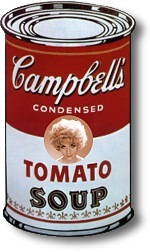|
A Reflective Interval
(also inevitable)
a) Art: transformation or calmness?
b) Is television an art form?
c) A few hypotheses
Steed becomes a British icon
Tara is caught eating Campbell's soup!
a) Art: Transformation
Or Calmness?
 One
of the greatest challenges an artist should cope with, either individually
or collectively, is to meet with their public's approval, despite the
inevitable changes and transformations their work experiences in time.
An artistic creation is always an indomitable force, that cannot be restricted
to parameters other than its own creative dynamics. And it's indeed in
this fidelity to its own origin where its freshness and power of communication
resides. One
of the greatest challenges an artist should cope with, either individually
or collectively, is to meet with their public's approval, despite the
inevitable changes and transformations their work experiences in time.
An artistic creation is always an indomitable force, that cannot be restricted
to parameters other than its own creative dynamics. And it's indeed in
this fidelity to its own origin where its freshness and power of communication
resides.
However, for some
strange reason we'll leave to psychologists, public tastes usually are
more conservative than any eager creative power. To the purists' way of
thinking, an ideal artist is the one whose work remains unalterable, stylistically
speaking, throughout the years. If there is something that abounds in
art history and showbiz, it is these permanent mix-ups between the public
and artists. Want a few examples? Musicians who have resigned themselves
to living in the shadow of an apparently "insuperable" earlier
hit; bands becoming drastically disapproved of for including new members
or replacing the old ones; film directors accused of treason for abandoning
a sort of cinema they were typecast in easily; TV shows consigned to memory
for having changed their habitual success formula.
Naturally, even though
transformation is something inherent to artistic creation, it cannot be
said that changes always guarantee quality or good artistic results. But
the opposite cannot be stated either. In general, the public is averse
to changes because that implies an instance of personal modification.
Viewers have to fight their reluctance to get used to the new, and this
irritability often generates a rejection of changes, leaving out any other
possible consideration. It is easier to condemn than to change, and the
major changes witnessed in The Avengers sixth season would not avoid this
fate.
In addition, the
show was changing not only as a result of internal dynamics, but also
due to external factors. For hundreds of reasons—political and socio-cultural—the
description of which would long exceed the scope of this article, 1968
began to become what John Lennon shortly afterwards summarized brilliantly
in his "Dream is Over." The entire world said goodbye to the
age of innocence, and the limpid, dreamy landscape of The Avengers began
to face, for the first time, the restlessness of a nightmare.
Time gives us the
chance of enhancing our vision of the series, covering it globally and
showing its faults and successes more accurately. However, the negative
response to changes, the lack of frames of reference, the general disagreement
and the uncertainty about the future, turned out to be a hindrance. Such
were the main problems the new avenging partners, Steed and Miss King,
were faced with, on and off the set, as a sort of allegory of that outer
world the series always ignored. Unfortunately, its recklessness would
be insufficient to ward the growing fears off. Fear brings to a halt,
and without dynamism, art becomes wilted.
But let's go on to
try to better understand the genesis of this creative paralysis...

|